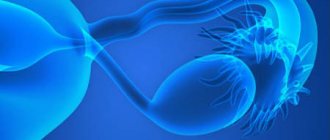Main causes of the symptom
The ovaries may hurt before each period.
This is due to the occurrence of physiological processes in the genital organs. Many women experience discomfort in the lower abdomen before bleeding begins, which is caused by the hormone progesterone, or during the fertile window - a few days before and after ovulation. The appendages may also hurt on days 1–2 of the cycle, which is also not considered a pathology in the absence of any diseases of the genital area. When pregnancy occurs and there is a delay in menstruation, the left or right ovary often hurts. The corpus luteum located in it produces progesterone, which is necessary for successful conception. After the fertilized egg attaches to the walls of the uterus, the gland begins to produce more hormones, which leads to its enlargement. This can cause pain in the ovary.
With the late onset of ovulation, the appendages hurt with low intensity on the left or right side of the lower abdomen. This is accompanied by a delay in menstruation, which occurs 10-13 days after the symptom.
The remaining possible causes of the conditions are considered pathological. These include:
- high level of prostaglandins – hormone-like lipid physiologically active substances;
- neoplasm on the ovary - pain in the lower abdomen on the left or right side, with hormonally active cysts and tumors there is a delay in menstruation;
- inflammatory process in the genital organs - the absence of an exact source of pain, it may be located in the center or on the sides of the pelvis;
- violation of the endocrine or reproductive function of the ovaries;
- rupture of the appendage or its cyst is an acute condition requiring immediate medical attention;
- endometrial pathologies - discomfort in the ovaries is difficult to differentiate from uterine pain due to the proximity of the organs;
- hormonal imbalance due to diseases of other endocrine organs - a delay in menstruation or their complete absence is likely.
The type of possible disease is determined by accompanying symptoms. An asymptomatic course is likely in the initial stages of the pathology. A diagnosis can only be made after an examination.
Delayed menstruation and ovary pain: pulling on the left and right appendage, no menstruation for 2 days
Every woman should closely monitor her menstrual cycle. If there is a delay, then you need to think that there may be something wrong with the body. Sometimes a girl feels pain in the abdomen and general weakness; discomfort is often observed in the right and left ovaries. In this article we will talk about the relationship between these two factors.
Causes
If ovarian pain is observed before menstruation, it is possible that the woman has late ovulation. In this regard, a slight delay may be associated with natural processes occurring in the body.
Important! It is worth paying attention to this symptom if pathologically painful sensations in the abdominal area are observed.
Doctors attribute such symptoms to the following reasons:
- cyst formation,
- the production of a huge amount of prostaglandins due to the strong filling of the pelvic vessels with blood,
- endometrial pathology,
- inflammatory processes in the appendages,
- successful conception,
- imbalance of key substances in the nervous system,
- ovarian dysfunction,
- late ovulation,
- ovarian apoplexy.
It is impossible to independently determine which of the reasons provoked the delay in the onset of menstruation. The attending physician will probably provide accurate information.
When not to worry
If the menstrual cycle is regular, then a delay of 1 or 2 days is normal.
Perhaps it is during this period that restructuring occurs in the body, or the woman is experiencing acclimatization after the trip.
Late ovulation is also possible.
One-time cases of this condition are allowed.
If your period does not come on time on a regular basis, then you should not delay going to the doctor.
Large amount of prostaglandins
Prostaglandins are substances that have various functions. They are provocateurs of menstruation, since thanks to them a certain spasm is caused in the vessels of the small pelvis. Doctors often call these elements “pain mediators.” The higher their concentration, the more discomfort the woman experiences.
Reference! Substances belong to the category of hormone-like. In this regard, pain during menstruation will be localized in the lower abdomen and ovaries.
The production of a large number of elements is due to the fact that the patient’s body is contaminated with toxins. In this regard, there is no need to constantly take medications, but should consult a specialist to eliminate the root cause.
Inflammation of the appendages
While waiting for the next menstruation, inflammatory processes may intensify.
They often indicate the following ailments:
- adnexitis,
- oophoritis,
- salpigit.
The above pathologies have a direct relationship with inflammation of the appendages. In this case, discomfort is equally observed in both the left and right ovaries. Sometimes unpleasant sensations are recorded periodically, but there are also cases when they are present on an ongoing basis.
Important! The main symptom here is pain referred to the lumbosacral part of the spine.
Associated factors of this disease include:
- increased irritability,
- weakness,
- lack of proper sleep,
- constant nervous tension.
The pathology affects the functioning of the immune system, hypothermia is observed.
Cyst and other neoplasms
Pain in the left ovary and a delay in scheduled bleeding is due to the fact that a cyst or other neoplasm has formed there. It can remain in the body for a long time and not manifest itself in any way. Until the cyst reaches a large size and the woman has undergone a special ultrasound, it is almost impossible to diagnose the pathology. However, subsequently the girl will feel discomfort.
The cyst tends to enlarge, resulting in pressure on the ovary. This is why discomfort occurs.
Hormonal disbalance
Hormone imbalance also affects the menstrual cycle.
If progesterone is not produced in sufficient quantities, discharge may be delayed.
Hormones also affect ovulation.
Untimely release of the egg provokes a delay.
Sometimes completely immature eggs can form in the follicles. As a result, ovulation does not occur in the middle of the cycle. Because of this, the corpus luteum, responsible for the production of progesterone, is not formed.
What to do?
If a woman notices certain symptoms in herself, then she should not engage in treatment. You need to seek help from a doctor.
The course of action here is as follows:
- the doctor takes anamnesis,
- then the doctor examines the patient on a gynecological chair, palpating the abdomen and ovaries,
- The next step in making a diagnosis is getting tested. In particular, urine and blood from a vein taken on an empty stomach are studied.
An informative method in diagnosis is ultrasound. The procedure allows you to determine the condition of the ovaries, whether follicles are forming, and whether fluid is present in the retrouterine space.
With the test results, the patient must return to the gynecologist’s office. Based on the information received, he makes a final diagnosis and determines a treatment regimen.
on this topic:
When a doctor's consultation is not required
There is no need to worry if the ovaries hurt on certain days of the cycle despite its complete regularity. A delay in menstruation can also occur in a healthy woman. This is likely for the following reasons:
- suffered stress;
- taking certain medications;
- climate change;
- the period of natural hormonal imbalance - postpartum, menopause and puberty.
Normally, a delay in menstruation should not exceed 1-5 days. Regular changes in cycle length indicate the presence of deviations in the functionality of the reproductive system.
Why do symptoms occur?
Pain in the ovaries and delayed menstruation indicate changes in the body. They can be both physiological and pathological. The exact cause can be determined by the accompanying symptoms.
Elevated prostaglandin levels
With a high concentration of these substances in the blood, the ovaries can hurt and there may be a delay in menstruation. In some women, the level of prostaglandins is always slightly elevated, which is expressed by the intense course of premenstrual syndrome, during which the ovaries hurt. This is usually observed in patients living in unfavorable environmental conditions or in hazardous working conditions.
Neoplasms
Cysts and tumors are often the reason why menstruation is delayed and women’s ovaries hurt. The appearance of discomfort is noted when the neoplasm reaches a size of more than 3–5 cm; capsules of a smaller diameter are present in the body asymptomatically.
With cysts of a functional nature, against the background of a delay in menstruation, both the right and left ovaries hurt. These include corpus luteum and follicular cysts.
The absence of menstruation in this case can be observed for 30-60 days. This pathology usually goes away on its own in 2-3 cycles, each of which usually includes a delay in menstruation. The ovaries hurt much more during menstrual bleeding due to a decrease in the size of the capsule and its gradual separation from the organ.
Many benign tumors do not cause a delay in menstruation due to the lack of their hormonal activity.
Inflammatory and infectious processes
The prolonged presence of infections in the genital tract contributes to the development of inflammation of the uterus and then the ovaries. With this condition, the lower abdomen hurts, there is a delay in menstruation, sometimes weakness, and increased body temperature. A distinctive feature of the infectious process is the presence of pathological vaginal discharge that has an unpleasant odor and a yellowish or greenish tint.
Inflammation of the ovaries can also occur against the background of reduced immunity, during recent gynecological operations, or hypothermia.
It can be one-sided or two-sided. In this case, one ovary hurts or the symptom is present on both sides of the lower abdomen. An acute inflammatory process is manifested by intense pain and high body temperature. In the chronic course of the pathology, patients complain that the appendages hurt; other signs of the disease are often absent. Delays of menstruation are possible, but with full functionality of the ovaries, the regularity of the cycle does not change.
If your periods are late and your ovaries hurt
Most modern girls regularly monitor their menstrual cycle, which allows them to detect even the most minimal delays.
And if menstruation is late and this is accompanied by pain, then many begin to think about the state of their health.
Quite often a situation arises when there is no period and the left ovary or the right ovary hurts. What is the connection between these symptoms?
Cause of pain
First of all, it should be noted that if pain appears before each menstruation, then, most likely, ovulation is just happening. Therefore, minor delay and pain may be due to physiological phenomena. However, if there was no problem before, but now your ovaries hurt and your periods are delayed, you should see a doctor for an examination.
Such manifestations may occur due to:
- The body produces excessive amounts of prostaglandins, which can cause congestion of the pelvic organs;
- Ovarian cyst formation;
- Inflammatory processes in the uterine appendages;
- Onset of pregnancy;
- Endometrial pathologies;
- Ovarian dysfunction;
- Nervous system disorders;
- Late onset of ovulation.
At home, it is impossible to accurately determine the cause of the condition in which there are no periods and the ovaries hurt, since the symptoms of the above problems are very often identical, and additional examination methods are needed.
Excessive production of prostaglandins
It should be noted that prostaglandins perform a large number of functions in our body. One of them is the induction of the onset of menstruation, when a spasm is provoked in the vessels of the pelvic organs. They are also called pain mediators. The more of them there are in the bloodstream, the more pain occurs when menstruation begins.
If the production of these substances is increased or a woman has a low pain threshold, then the ovaries and lower abdomen may become ill during the critical days every month.
Doctors associate the increase in the concentration of prostaglandins with the presence of various toxins in the body.
This means that the ideal way to combat pain is to find the root cause, rather than taking various drugs to relieve pain.
Ovarian cyst
Very often, if your period is not on time, pain appears on the left side, you can suspect an ovarian cyst. This formation does not always manifest itself immediately, since pain appears when the cyst reaches a large size or several cysts develop at once. Most often it affects the left ovary.
Pain appears during the delay before the onset of menstruation due to the fact that it is at this moment that the cyst enlarges and puts pressure on the organ that reacts with pain.
Inflammatory processes in the uterine appendages
The phenomena of inflammation that accompany pathologies such as salpingitis, oophoritis or adnexitis usually become active before critical days.
Usually the ovaries hurt on both sides, but the pain occurs periodically. In some cases, it bothers you for a long time. A characteristic symptom is pain in the lower abdomen radiating to the sacrum.
Quite often, these diseases can be accompanied by the following symptoms:
- Sleep disorders;
- Weakness, lethargy, weakness;
- Irritability and excessive nervousness.
The provoking factor for inflammation of the uterine appendages is usually infectious processes, decreased immunity due to hypothermia, and malfunctions of the immune system.
Late onset of ovulation
A delay in menstruation with accompanying pain in one ovary can be caused by a late onset of ovulation. After the egg is released from the ovary, the follicle ruptures and the corpus luteum is formed. It is responsible for the production of progesterone, which also acts as a regulator of the menstrual cycle.
If disorders have developed in the female body due to which ovulation is delayed, then the corpus luteum will form later, and the synthesis of the hormone will also be delayed. Ultimately, this will lead to a delay in menstruation and the development of pain.
Ovulation can be determined using the following methods:
- A special test for ovulation, however, its results are often unreliable;
- Ultrasound of the pelvic organs gives an answer with high accuracy;
- Blood test for hormone levels.
It should also be noted that disturbances in the functioning of the corpus luteum can be provoked by the presence of hormonal imbalance, excessive stress or infectious processes.
Ovarian dysfunction
The concept of ovarian dysfunction includes all kinds of hormonal pathologies that can be caused by dysfunction of these organs.
They are recognized by a long delay in menstruation and the presence of uterine bleeding after menstruation, which can last more than seven days.
Also, the pathology can be diagnosed due to the irregularity of the onset of menstruation with a decrease in the time interval between them, when it is less than three weeks. They are called dysfunctional uterine bleeding.
The presence of such a pathology can be indicated by severe premenstrual syndrome, amenorrhea - the absence of menstruation for a long time in the absence of pregnancy and female infertility.
Psychogenic causes
Nervous tension can occur with diseases such as depression, hypochondria, emotional burnout, hysteria and others. It can easily affect metabolic processes in the body, as well as cause any pathological process, which may include the development of pain in the lower abdomen when menstruation is delayed.
This diagnosis is established when a comprehensive examination was carried out, during which no possible cause of pain and delayed menstruation was identified.
However, such problems should not be considered safe for the female body, since they can provoke other pathological situations.
In order to eliminate psychosomatic pathologies that lead to changes in a person’s physical status, you should pay attention to your lifestyle. First of all, the factors that cause negativity should be eliminated.
Sometimes consultations and treatment with psychologists and neurologists are necessary, who can prescribe special courses of treatment for psychological and psychosomatic problems.
Summarizing
Regular pain in the lower abdomen during delayed menstruation is quite often physiological, especially when it comes to delayed ovulation. However, if menstruation still does not begin, and the lower abdomen continues to bother you, you should consult a specialist.
Procrastination “for later” will not only add more work to doctors, but will also negatively affect your health.
If, in addition to pain and a delay in menstruation, symptoms such as severe weakness, pain have intensified significantly, and the skin has turned pale, you should immediately call an ambulance, take a horizontal position and not refuse the proposed hospitalization.
Source: https://GormonOff.com/zabolevanija/reproductive/esli-est-zaderzhka-mesyachnyx-i-bolyat-yaichniki
Late ovulation
Typically, rupture of the follicle and release of the egg occurs on the 14-15th day from the start of menstruation under the influence of estrogens, luteinizing and follicle-stimulating hormones. A delay in menstruation in this case, in the absence of pathologies, is likely only when pregnancy occurs. When hormone levels are low, the timing of ovulation shifts. This is possible due to climate change, stress or failure of the endocrine function of the appendages.
With late rupture of the follicle, the ovaries may hurt on the 20-25th day of the cycle, sometimes later. If this condition occurs once, there is no need to worry; regular changes in cycle length require diagnosis. The course of ovulation can be determined by a delay in menstruation, a negative pregnancy test in which the left or right ovary hurts, or vaginal discharge that resembles the white of a chicken egg.
In some women, follicle rupture always occurs no earlier than 20-25 DC (day of the cycle) - this is considered an individual characteristic of the body. The duration of the monthly cycle in this case is about 35 days.
Onset of pregnancy
The main sign of pregnancy is a delay in menstruation.
This condition is accompanied by weakness, drowsiness, mood swings, and enlarged mammary glands. Sometimes women have pain in the ovary, which is caused by increased activity of the corpus luteum. This symptom may also indicate the formation of a cyst. In any case, after receiving a positive result on a pregnancy test, you should consult a doctor for registration.
In late gestation, the appendages rarely hurt. The symptom is often confused with discomfort from stretching of the uterine ligaments.
Violation of the appendages
The ovaries, when their functionality is impaired, often begin to hurt. This is accompanied by a failure of the cycle - its shortening, delays in menstruation, intermenstrual uterine bleeding. Against the background of such deviations, cysts often develop. Long-term lack of treatment can lead to complete ovarian dysfunction - early onset of menopause and, as a result, infertility.
Apoplexy
Both ovarian rupture and cysts are likely. In both conditions, there is pain in the lower abdomen, nausea, vomiting, weakness, cold sweat, a drop in blood pressure and an increase in body temperature. During apoplexy of a neoplasm, its contents and traces of blood enter the abdominal cavity, and rupture of the appendage itself causes internal bleeding. In both cases, if there is a delay in providing medical care, there is a high probability of developing extensive peritonitis.
Pain in the ovary during pregnancy
As noted above, a slight feeling of pain in one of the ovaries may indicate pregnancy. An unpleasant sensation occurs when the egg is fertilized by a sperm. This process indicates the release of the hormone progesterone, which indicates a normal pregnancy.
In some cases, this symptom indicates the beginning of softening of the pelvic muscles and gradual expansion of the uterus. These symptoms are typical for pregnancy and do not pose any threat.
Most rarely, a cyst may form at the site of the follicle, which begins to grow after pregnancy. As it increases, pain may increase, which indicates stretching of the ovary. The main thing is that this phenomenon does not require treatment and also does not pose any danger.
Before conception, it is recommended to remove the cyst, since there is a high risk of ectopic pregnancy. If the test is positive, and the cyst appeared earlier, then this case does not require intervention or treatment.
Elimination methods
Initially, if there is pain in the appendages and delays in menstruation, a woman should undergo diagnostics. It includes the following studies:
- Ultrasound of the pelvis;
- gynecological examination;
- vaginal smear;
- general blood and urine tests;
- checking hormone levels;
- pregnancy test or blood donation for hCG levels.
In the absence of deviations, it is established that the ovaries hurt during physiological processes in the body. To alleviate this symptom, a woman is allowed to take painkillers.
With regular monthly delays, deviations cannot go unnoticed. Against the background of this condition, the appendages may hurt. The following drugs are prescribed for treatment:
- anti-inflammatory – during oophoritis, adnexitis;
- antibiotics – in the presence of pathogenic microorganisms in the genital tract;
- non-steroidal anti-inflammatory drugs - relieve inflammation and pain;
- hormonal drugs and oral contraceptives - restore the course of menstruation when the endocrine function of the appendages fails;
- vitamin complexes - speed up the healing process, prevent delays in menstruation, regulating the cycle.
Self-medication is prohibited, as this can provoke the appearance of a chronic stage of the identified disease. To prevent pathologies, a woman is recommended to visit a gynecologist every six months.
The ovaries often hurt on certain days of the cycle against the background of physiological processes. Delays in menstruation should normally occur no more than 1-2 times a year. To exclude possible diseases of the genital area and the regular occurrence of pain in the appendages or changes in the length of the cycle, you should contact a gynecologist for examination.









